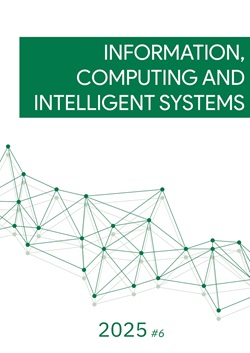Drone Swarm Control Model Based on High-Level Petri Nets
DOI:
https://doi.org/10.20535/2786-8729.6.2025.333220Keywords:
Unmanned Aerial Vehicle, Drone, High-level Petri Net, simulation, controlAbstract
The rapid growth of unmanned aerial vehicle (UAV) applications in the modern world imposes significant demands on the reliability of control logic. An error in the sequence of stages can lead at best to inefficient battery usage or violations of airspace regulations, and at worst to an accident with loss of the vehicle and potential harm. Control is usually implemented using scripts or behavior trees, which complicates maintenance. The reason is that the size of the source files quickly increases, and when it becomes necessary to add new functionality or modify existing logic, there is a risk of introducing vulnerabilities by failing to account for all possible situations. This is why High-Level Petri Nets (HLPN) were chosen, as this method addresses the problem of formally describing the control system and allows the system to be easily scaled or modified in any way.
The aim of the study is to develop and validate a model based on HLPN that will serve as the single source of truth for UAV swarm control. In the proposed model, the places correspond to flight stages, and the tokens carry numerical parameters such as battery charge, coordinates, and telemetry. Thus, a single scheme simultaneously describes discrete events and constraints. For each transition, conditions are formalized to verify the possibility of its execution, such as checking the minimum required battery level or verifying location.
The methodology includes several stages. First, the network structure is formally defined. Then, based on this structure, a Python model is built that implements the developed network, controls movement between states, and ensures the correct sequence of transition firings. After developing the model, testing and analysis of the obtained results are performed.
The results show that using HLPNs to build a model for verifying commands in a discrete mode indeed ensures a correct description of transitions between states and increases the reliability and survivability of the developed control system model, while also significantly reducing maintenance efforts. The developed model is easily adaptable to route changes, addition of sensors, or functional expansion.
References
ISO/IEC 15909-1:2019 – High-level Petri nets – Part 1: Concepts, definitions and graphical notation, International Organization for Standardization, Geneva, Switzerland, 2019
R. David, H. Alla, Discrete, Continuous and Hybrid Petri Nets, 2nd ed. Berlin, Germany: Springer, 2010, pp. 337
S. Byun, D. Lee, “Performability Evaluation of Autonomous Underwater Vehicles Using Phased Fault Tree Analysis”. Journal of Marine Science and Engineering. vol. 12(4) pp. 564–575, 2024, https://doi.org/10.3390/jmse12040564
A. Fedorova, V. Beliautsou, & A. Zimmermann. “Colored Petri Net Modelling and Evaluation of Drone Inspection Methods for Distribution Networks”. Sensors, vol. 22(9), pp. 3418–3438, 2022, doi: https://doi.org/10.3390/s22093418
P. Bizhao, H. Xinting, D. Wei, H. L. Kin, “UAV path optimization with an integrated cost assessment model considering third-party risks in metropolitan environments”. Reliability Engineering & System Safety, vol. 222, Art. no.108399, 2022, https://doi.org/10.1016/j.ress.2022.108399
H. Qin, B. Zhao, L. Xu, X. Bai, “Petri-Net Based Multi-Objective Optimization in Multi-UAV Aided Large-Scale Wireless Power and Information Transfer Networks.” Remote Sensing, vol. 13(13), pp. 2611–2630, 2021, https://doi.org/10.3390/rs13132611
X. Wang, Y. Guo, N. Lu, P. He, “UAV Cluster Behavior Modeling Based on Spatial-Temporal Hybrid Petri Net.” Applied Sciences, vol. 13(2), pp.762–778, 2023, https://doi.org/10.3390/app13020762
Gazebo, “Getting Started with Gazebo”, gazebosim.org, Accessed: May 6, 2025. [Online] Available: https://gazebosim.org/docs/latest/getstarted/
C. Brito, L. Silva, G. Callou, T.A. Nguyen, D. Min, J.-W. Lee, F.A. Silva, “Offloading Data through Unmanned Aerial Vehicles: A Dependability Evaluation.” Electronics, vol. 10(16), pp.1916–1934, 2021, https://doi.org/10.3390/electronics10161916
M. A. Trigos, A. Barrientos, J. del Cerro, “Systematic process for building a fault diagnoser based on Petri nets applied to a helicopter.” Mathematical Problems in Engineering, vol. 1, 13 p., 2015, https://doi.org/10.1155/2015/963756
A. Bertolaso, M. Raeissi, A. Farinelli, R. Muradore, “Using Petri Net Plans for Modeling UAV–UGV Cooperative Landing” Frontiers in Artificial Intelligence and Applications vol. 285, pp.1720–1721, 2016, https://doi.org/10.3233/978-1-61499-672-9-1720
Downloads
Published
How to Cite
Issue
Section
License
Copyright (c) 2025 Information, Computing and Intelligent systems

This work is licensed under a Creative Commons Attribution 4.0 International License.




